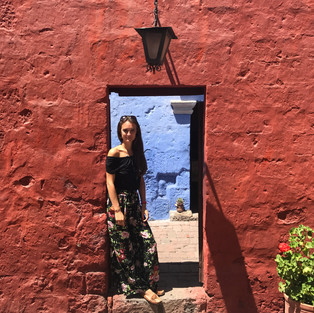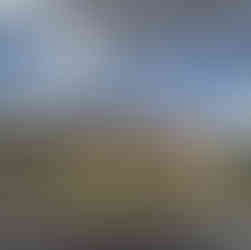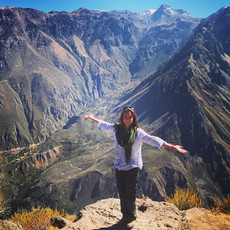The Ultimate Itinerary for 8 Days in Peru (Including Machu Picchu-without the trek!)
- Eleanor's Footsteps
- Aug 20, 2020
- 8 min read
Arequipa, Cusco, Machu Picchu, Lima

Peru is normally sat high on many people’s travel bucket list, with its diverse landscapes, unrivalled cuisine and, of course, the specular Machu Picchu, one of the seven Modern Wonders of the World. There is so much to see and it can be difficult to pack everything in to just one trip, so if you are unsure where to start, here is the itinerary we followed for 8 days and a few top tips we picked up along the way:
Day 1: Fly London to Arequipa (via Lima)
We flew with British Airways from Gatwick to Lima, the capital of Peru, then took a connecting flight straight to Arequipa with LATAM, a South American airline. Arequipa is a stunning colonial-style city south east of Lima, set at the foot of Misti mountain and framed by three active volcanoes. It is a buzzing city with real character and bright Peruvian charm- it is the perfect way to start your trip.
This was a very tight connection for us as we did not check our luggage all the way through and the queues through immigration meant that we did not have much time to do this. If you have time, it may be worth staying the night in Lima and then flying to Arequipa the next day. LATAM was a fantastic airline which we used a number of times throughout our trip and the flights were easy to book before we left.
It was easy to find taxis at Arequipa airport into the city centre. Once in Arequipa, I would recommend staying at the Casa Andina Select Arequipa Plaza (https://www.casa-andina.com/es/destinos/arequipa/hoteles/casa-andina-select-arequipa -double from £74, Aug 2020), located on the Plaza de Armas, the main square in the city. The Basilica Cathedral of Arequipa is the perfect backdrop for breakfast each morning on the terrace, and the rooftop pool is the perfect place to relax after a busy day exploring.
Day 2: Explore Arequipa
The Monasterio de Santa Catalina (https://santacatalina.org.pe) is a must, a tranquil oasis only a short walk from the central square. Once you enter the high walled campus, a maze of bright terracotta and cobalt blue courtyards await, contrasting spectacularly in the sunshine. The nuns of the Dominican Second Order still reside on the premises and you can sometimes catch a glimpse of them tending to their gardens between prayers. Towards the end of the visit, climb up to the roof of the monastery (it is all single or two storey buildings so not a high climb), which provides one of the best views of the city.
After lunch, make sure to visit Mundo de Alpaca (Alpaca world), a free, small outdoor museum and shop dedicated to the art of weaving the wool created from these beautiful animals. Peru accounts for 80% of the world’s alpaca population and these adorable animals are an integral part of Andean life. Alpaca wool is very soft as well as insulating, making it very popular for clothing. You can pick up socks, hats, gloves etc in pretty much every gift store across the country. Sometimes demonstrations will take place at the looms and the staff are very happy to tell you about how the garments are made. Wander into the gardens behind and you can meet the alpaca themselves. We were lucky enough to catch them during lunchtime and had the chance to feed these adorable creatures. More information can be found at: https://www.mundoalpaca.com.pe.
Day 3: Colca Canyon
Colca Canyon is the second most popular attraction in Peru after Machu Picchu. It is the second deepest canyon in the world and is twice as deep as the Grand Canyon in the USA. Popular for hiking, it is also a great place to watch the impressive condors soaring in the valley below.
We did this as part of an organised day tour using one of the tourist offices on the Plaza de Armas. There were lots of places in Arequipa to book this, so have a look around for the best option for you and book it the day before. It is a long drive, the trip starts at 3am from the main square and returns at 5pm. All the companies will arrive in different buses at the same time to the main square so make sure you know which company you booked the tour with and that you have a contact number in case they are running late. One of the highlights of the scenic drive was the climb up before the canyon, where we reached 16,000ft above sea level, the highest elevation that I had been. Lunch was provided in the local village by a small restaurant, where the staff wore traditional dress and showed off some of the dances and skills once a regular part of rural Peruvian life.

Day 4: Fly Arequipa to Cusco
Cusco is commonly used as a base for those travelling onward to Macchu Pichu, however the city itself is beautiful and is well worth visiting in its own right. We took the first flight in the morning with LATAM. If you can, get a window seat for this leg as it is a truly beautiful flight. We saw an erupting volcano on the climb out of Arequipa and the approach into Cusco is well known for be a challenging amongst the terrain, making the views well worth it as a passenger! We used the rest of this day to walk along the narrow, cobbled streets of the city, weaving our way in and out of local boutiques, craft workshops and the outdoor clothing shops (just in case you forget anything for the trek!). We stayed in two gorgeous hotels in Cusco, one before and one after our trip to Machu Picchu, both of which I would happily recommend. The first was Antigua Casona San Blas (http://antiguacusco.com/, double from £126, Oct 2020), and the second was Rumi Punku Hotel (https://www.rumipunku.com/?lang=en, double from £84, Sept 2020).
If you are looking for somewhere to eat, my favourite restaurant in Cusco was Cicciolina (http://www.cicciolinacuzco.com). They serve a variety of Peruvian and international cuisine, with tapas and main dishes available in the casual bar and a full menu in the formal dining room. We ate in both the bar and the dining room during our stay and can highly recommend both. Ciiciolina also provide picnics for daytrips and have a bakery for fresh bread in the morning. It is highly recommended to book the dining room, however you do not normally need reservations for the tapas bar.
Day 5: Train to Aguas Calientes.

Aguas Calientes the base town at Machu Picchu. It is a tourist hotspot, built in a narrow valley at the Andean mountains. Filled with small hotels and souvenir market stalls, you do not need to spend much time here and just use it as somewhere to rest during your time at Machu Picchu. There are two main options to reach this town: the Inca Trail trek or the PeruRail train. If you want to do the full trek then it is well worth organising this separately with a group.
We took the train, which does the full four day trek in three and a half hours. The train was booked with PeruRail at https://www.perurail.com/ . It is worth booking the Vistadome train, as these cars have panoramic windows, which allow you to watch the stunning scenery go past. It is quite expensive (approx. 80 USD each way, Aug 2020) and you have to book far in advance for the train, but this was the best bit of the trip and the only way to Aguas Calientes unless you trek. Once you arrive in Aguas Calientes, it is worth buying the bus ticket for Macchu Pichu for the next morning. Make sure to go for the first bus. You will then want to get an early night, we stayed at Gringo Bill’s Hotel (https://www.gringobills.com/en-gb , doubles from £37, Aug 2020), which was good as a base.
Day 6: Machu Picchu.

Machu Picchu, known as ‘the Lost City of the Incas’, was undiscovered during the Spanish conquest due to its position high in the mountains and as a result it was left preserved in it’s original state. The name literally means “Old Mountain” and it was rediscovered by Professor Hiram Bingham in 1911.
You will need to book your visit to Machu Picchu far in advance. There are lots of fake websites so make sure to go through the official government website (https://www.machupicchu.gob.pe/?lang=en ). Be aware that on top of booking the site, you will also need to email a photo of your Machu Picchu entrance stamp (which should be emailed to you) to the authorities when entering into Peru, but they will tell you about that when you book online. Machu Picchu is nestled between two mountains, Moñtana Machu Picchu and Hauyna Picchu. While booking the site entry (go for the morning slot), you should also book to climb the Machu Picchu mountain for the first 7am slot. Both of the mountains require extra tickets if you wish to climb them and people were being turned away for not having the ticket to enter the mountains. We climbed Montaña Machu Picchu, and I would highly recommend this one, as it is higher and the views down at the ancient site are amazing.
You should have already got the bus ticket the day before to save time. Be in the bus queue (make sure it is actually the one for the bus itself and not for the tickets!) for at latest 5:15am, or you will be waiting for hours in line. The first bus is at 6am and they flow in convoy all day. When you arrive at the top of the mountain, it will be very tempting to go and take lots of photos in Machu Picchu itself, but instead go straight to the mountain and do this first. You can then descend down in your own time and relax while looking around the citadel. When you are finished (or your morning slot has finished) return to Aguas Calientes by bus. We got the PeruRail train back to Cusco that night. On the return leg, the staff put on a show showing each of the Gods and Demons that were symbolised in Andean life. This helped the time pass and kept our energy levels high on the journey back.
Day 7: Cusco
We were pretty tired after Machu Picchu the previous day so took this day to relax. If you have the energy or more time then consider visiting Rainbow Mountain or the Amazon Rainforest. Both of these daytrips are easily available to book in Cusco at any of the tourist desks. Do not underestimate the previous day though as we were surprised at how much we valued this rest day.
Day 8: Fly Cusco to Lima
We flew back to Lima early in the morning and had all day before our evening flight back to London. We left our suitcases in the airport luggage storage (this is very easy and there is a porter who will look after the bags in a store room. It is worth making sure you have a padlock on your suitcase if leaving any belongings for a long period of time unattended). It is a taxi ride into town and the traffic can be very bad, so make sure to leave enough time for this. The main square is pretty, but there is not a huge amount for tourists in Lima, so we headed to the Miraflores district. Here we were able to sample the country’s famous Pisco sour drink and stroll along the pretty mosaic coastal walkway. After a few hours we returned to the airport for the flight home.

Packing Top Tip:
Travel using only hand luggage.
Yes, this sounds crazy, but it is possible! Work out what clothes can be re-worn and what you actually need. This saves a lot of stress with flight connections and beware: there are no suitcases allowed on the train to Machu Picchu! If you do feel the need to carry a suitcase, it would be worth leaving it in a hotel or storage in Cusco for the train journey and just carrying a small overnight back to Aguas Calientes.


































Comments